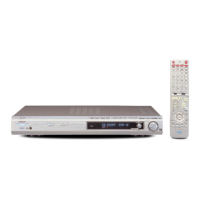45
ENGLISH
21
TROUBLESHOOTING
If a problem should arise,first check the following.
1. Are the connections correct ?
2. Have you operated the receiver according to the Operating Instructions ?
3. Are the speakers, turntable and other components operating property ?
If this unit is not operating properly, check the items listed in the table below. Should the problem persist, there
may be a malfunction.
Disconnect the power immediately and contact your store of purchase.
Symptom Cause Measures Page
DISPLAY not lit and
sound not produced
when power switch
set to on.
• Power cord not plugged in securely. • Check the insertion of the power cord
plug.
6
DISPLAY lit but sound
not produced.
• Speaker cords not securely connected.
• Improper position of the audio function
button.
• Volume control set to minimum.
• MUTING is on.
• Digital signals not input Digital input
selected.
• Connect securely.
• Set to a suitable position.
• Turn volume up to suitable level.
• Switch off MUTING.
• Input digital signals or select input jacks
to which digital signals are being input.
9, 10
19
20
21
19
DISPLAY not lit and
power indicator is
flashing rapidly.
• Speaker terminals are short-circuited.
• Block the ventilation holes of the set.
• The unit is operating at continuous high
power conditions and/or inadequate
ventilation.
• Switch power off, connect speakers
properly, then switch power back on.
• Turn off the set’s power, then ventilate it
well to cool it down.
Once the set is cooled down, turn the
power back on.
• Turn off the set’s power, then ventilate it
well to cool it down.
Once the set is cooled down, turn the
power back on.
9, 10
3
3
Sound produced only
from one channel.
• Incomplete connection of speaker cords.
• Incomplete connection of input/output
cords.
• Connect securely.
• Connect securely.
9, 10
6 ~ 10
Positions of
instruments reversed
during stereo playback.
• Reverse connections of left and right
speakers or left and right input/output
cords.
• Check left and right connections. 10
Common problems when listening to the CD, records, tapes and FM broadcasts, etc.
Symptom Cause Measures Page
Humming noise
produced when record
is playing.
• TV or radio transmission antenna nearby. • Contact your store of purchase. —
Howling noise
produced when
volume is high.
• Turntable and speaker systems too close
together.
• Floor is unstable and vibrates easily.
• Separate as much as possible.
• Use cushions to absorb speaker
vibrations transmitted by floor. If
turntable is not equipped with insulators,
use audio insulators (commonly
available).
—
—
Sound is distorted.
• Stylus pressure too weak.
• Dust or dirt on stylus.
• Cartridge defective.
• Apply proper stylus pressure.
• Check stylus.
• Replace cartridge.
—
—
—
When playing records
Remote control unit
This unit does not
operate properly when
remote control unit is
used.
• Batteries dead.
• Remote control unit too far from this
unit.
• Obstacle between this unit and remote
control unit.
• Different button is being pressed.
• < and > ends of battery inserted in
reverse.
• Replace with new batteries.
• Move closer.
• Remove obstacle.
• Press the proper button.
• Insert batteries properly.
10
10
—
—
10
Speaker system (SYS-550SD)
Active subwoofer (DSW-3L):
LED does not light and
no sound is produced
when power is turned
on.
• AC power plug is not securely
connected.
• Check the connection of the AC power
plug.
37
Active subwoofer (DSW-3L):
LED lights but no
sound is produced.
• Cords are not securely connected.
• Volume adjustment control is turned all
the way down.
• Connect securely.
• Turn the control and set it to the desired
position.
9, 10
Active subwoofer (DSW-3L):
LED flashes and no
sound is produced.
• Protective circuit has been activated
due to excess input or rise in
temperature.
• Set the power switch to the “OFF”
position, wait at least 1 minute, then
set the power switch back to the “ON”
position. If the problem persists, unplug
the AC power cord from the AC power
outlet and contact your store of
purchase.
—
Active subwoofer (DSW-3L):
Sound is distorted.
• Volume level is too high.
• Sound is being distorted on connected
amplifier.
• Turn the volume adjustment control
counterclockwise to lower the volume.
• Do not amplify the bass sound on the
amplifier. (Lower the amplifier’s bass
adjustment control or volume.)
37, 38
Active subwoofer (DSW-3L):
Oscillation (loud continuous
sound produced).
• Volume of active subwoofer or
amplifier set too high.
• Lower the volume of the active
subwoofer or amplifier.
37, 38
For improvement purposes, specifications and design are subject to change without notice.

